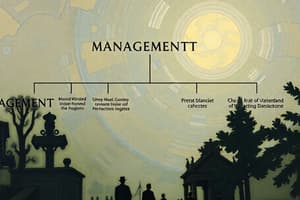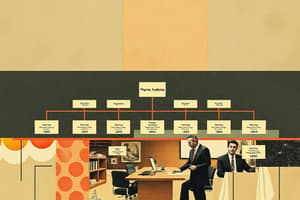Podcast
Questions and Answers
What is the primary characteristic of a functional organizational structure?
What is the primary characteristic of a functional organizational structure?
- Employees grouped by product lines
- Employees with decentralized decision-making
- Employees grouped by geographic locations
- Employees grouped by specialized skills or roles (correct)
Which management function involves establishing relationships among individuals and groups?
Which management function involves establishing relationships among individuals and groups?
- Leading
- Controlling
- Organizing (correct)
- Planning
What does Total Quality Management (TQM) primarily aim to achieve?
What does Total Quality Management (TQM) primarily aim to achieve?
- Continuously improve quality across processes (correct)
- Optimize work processes through analysis
- Strictly adhere to bureaucratic rules
- Maximize output of resources
Which leadership style is characterized by independent decision-making without employee input?
Which leadership style is characterized by independent decision-making without employee input?
What is a defining feature of matrix organizational structures?
What is a defining feature of matrix organizational structures?
Which theory suggests that management approaches should adapt to specific circumstances?
Which theory suggests that management approaches should adapt to specific circumstances?
What aspect does human relations management emphasize in motivating employees?
What aspect does human relations management emphasize in motivating employees?
What is a common goal of lean management practices?
What is a common goal of lean management practices?
What type of leadership focuses primarily on achieving results through clearly defined tasks and responsibilities?
What type of leadership focuses primarily on achieving results through clearly defined tasks and responsibilities?
Which theory suggests that understanding employee needs is crucial for motivation?
Which theory suggests that understanding employee needs is crucial for motivation?
What is a potential downside of group decision-making?
What is a potential downside of group decision-making?
Which of the following models emphasizes the steps of unfreezing, changing, and refreezing during an organizational change?
Which of the following models emphasizes the steps of unfreezing, changing, and refreezing during an organizational change?
Which conflict management style is characterized by a focus on assertiveness and a pursuit of one's own goals without regard for others?
Which conflict management style is characterized by a focus on assertiveness and a pursuit of one's own goals without regard for others?
What is a primary characteristic of a strong organizational culture?
What is a primary characteristic of a strong organizational culture?
What aspect is most likely to enhance employee engagement in an organization?
What aspect is most likely to enhance employee engagement in an organization?
Which type of decision-making relies mainly on past experiences and intuition?
Which type of decision-making relies mainly on past experiences and intuition?
What common factor can drive the need for organizational change?
What common factor can drive the need for organizational change?
Which leadership style is primarily focused on meeting the needs of employees and stakeholders?
Which leadership style is primarily focused on meeting the needs of employees and stakeholders?
Flashcards
Organizational Structure
Organizational Structure
The way an organization groups its employees and resources.
Functional Structure
Functional Structure
Grouping employees based on specialized job skills (e.g., marketing, finance).
Management Functions
Management Functions
The core activities of managing resources: planning, organizing, leading, and controlling.
Scientific Management
Scientific Management
Signup and view all the flashcards
Leadership Styles - Autocratic
Leadership Styles - Autocratic
Signup and view all the flashcards
Leadership Styles - Democratic
Leadership Styles - Democratic
Signup and view all the flashcards
Contingency Theory
Contingency Theory
Signup and view all the flashcards
Planning (Management Function)
Planning (Management Function)
Signup and view all the flashcards
Transformational Leadership
Transformational Leadership
Signup and view all the flashcards
Transactional Leadership
Transactional Leadership
Signup and view all the flashcards
Servant Leadership
Servant Leadership
Signup and view all the flashcards
Employee Motivation
Employee Motivation
Signup and view all the flashcards
Maslow's Hierarchy of Needs
Maslow's Hierarchy of Needs
Signup and view all the flashcards
Herzberg's Two-Factor Theory
Herzberg's Two-Factor Theory
Signup and view all the flashcards
Expectancy Theory
Expectancy Theory
Signup and view all the flashcards
Rational Decision Making
Rational Decision Making
Signup and view all the flashcards
Bounded Rationality
Bounded Rationality
Signup and view all the flashcards
Intuitive Decision Making
Intuitive Decision Making
Signup and view all the flashcards
Study Notes
Organizational Structure
- Organizations are structured in various forms, each with unique characteristics and implications for efficiency and effectiveness.
- Common structures include functional, divisional, matrix, and flat structures.
- Functional structures group employees by specialized skills or roles.
- Divisional structures group employees by product, geography, or customer.
- Matrix structures combine elements of functional and divisional structures.
- Flat structures have few hierarchical levels, promoting decentralized decision-making.
- The optimal structure depends on factors such as organizational size, industry, and strategic goals.
Management Functions
- Management encompasses planning, organizing, leading, and controlling organizational resources.
- Planning involves defining objectives and developing strategies to achieve them.
- Organizing involves allocating resources and establishing relationships among individuals and groups.
- Leading involves motivating and directing employees towards organizational goals.
- Controlling involves monitoring performance and taking corrective actions as needed.
- Effective management requires the ability to adapt to changing circumstances and make informed decisions.
Management Theories
- Several theories aim to explain and enhance management practices.
- Scientific management focuses on optimizing work processes through scientific analysis.
- Administrative management emphasizes principles of management across different organizations.
- Bureaucratic management emphasizes rules, regulations, and a clear hierarchy.
- Human relations management emphasizes the importance of social and psychological factors in employee motivation.
- Contingency theory suggests that there is no one best way to manage, and the optimal approach depends on the context.
- Systems theory views organizations as interconnected systems with inputs, processes, outputs, and feedback loops.
- Total Quality Management (TQM) seeks to continuously improve quality across all organizational processes.
- Lean management aims to eliminate waste and maximize efficiency in processes.
Leadership Styles
- Management styles vary significantly in their approach to leading teams.
- Autocratic leaders make decisions independently, often without employee input.
- Democratic leaders involve employees in decision-making.
- Laissez-faire leaders offer limited guidance, allowing employees considerable autonomy.
- Transformational leaders inspire and motivate employees to achieve exceptional results.
- Transactional leaders focus on clarifying tasks and responsibilities.
- Servant leadership prioritizes serving the needs of employees and stakeholders.
Motivation and Employee Engagement
- Motivation is crucial for employee performance and organizational success.
- Theories such as Maslow's hierarchy of needs, Herzberg's two-factor theory, and expectancy theory provide insights into employee motivation.
- Incentives, recognition, and a supportive work environment contribute to employee motivation.
- Effective communication, clear expectations, and opportunities for growth can enhance employee engagement.
- Employee engagement leads to higher productivity, lower turnover, and improved organizational performance.
Decision Making
- Effective decision making is a critical management function.
- Rational decision-making models propose a systematic approach involving identifying problems, evaluating alternatives, and selecting the best course of action.
- Bounded rationality recognizes that decision-makers are limited by cognitive constraints and time.
- Intuitive decision-making involves using experience and judgment to make choices.
- Group decision-making can leverage diverse perspectives but can also be slower and more prone to conflict.
Organizational Change
- Organizations often need to adapt and change to remain competitive.
- Change management strategies are essential to successfully navigate transitions.
- Factors such as technological advancements, market trends, and globalization can drive organizational changes.
- Resistance to change is common; communication and support are essential to address it.
- Strategies like Lewin's three-step model for change (unfreezing, changing, refreezing) are applied to manage change.
- Effective leadership, communication, and training can facilitate successful organizational change.
Conflict Management
- Conflict is inevitable in organizations and can arise from various sources.
- Understanding different conflict management styles (e.g., competing, collaborating, compromising, avoiding, accommodating) is important for effective resolution.
- Constructive conflict can stimulate innovation and improve decision-making.
- Destructive conflict can hinder productivity and damage relationships.
- Strategies such as negotiation, mediation, and arbitration can be used to manage organizational conflict.
Organizational Culture
- Organizational culture encompasses the shared values, beliefs, norms, and behaviors of an organization.
- Strong cultures can foster commitment and shared identity among employees.
- Weak cultures may result in inconsistent behaviors and communication.
- Building a positive and supportive culture is crucial for success.
- Organizational culture influences employee motivation and engagement.
- Leading by example, consistent reinforcement of values, and promoting respectful interactions can shape organizational culture.
Studying That Suits You
Use AI to generate personalized quizzes and flashcards to suit your learning preferences.



